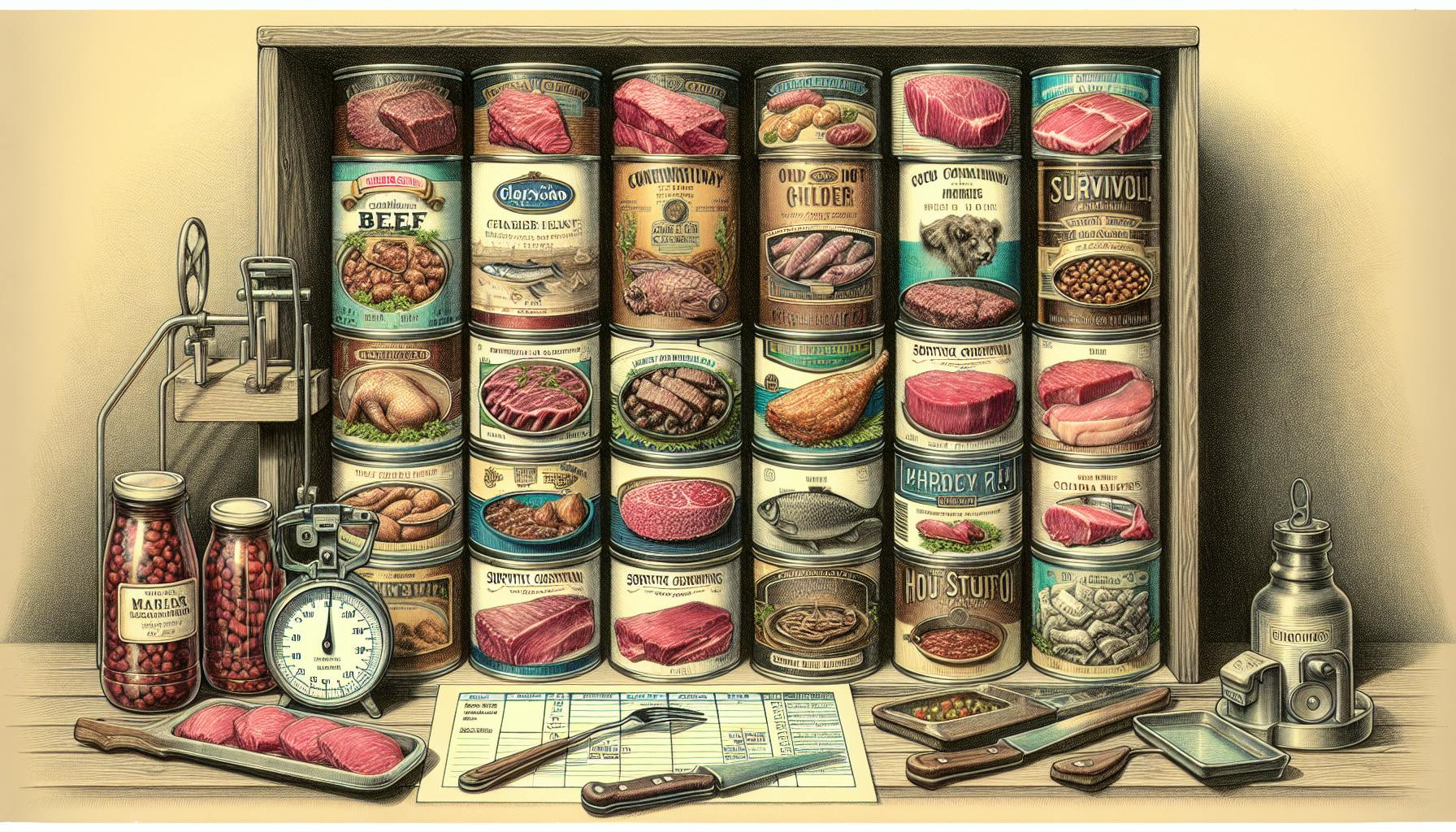When crisis strikes, having the right emergency supplies can make all the difference.
This article will provide a complete list of the most essential items to include in an emergency backpack kit, ensuring you're fully prepared for any situation.
We'll cover everything from high-quality gear for survival basics like food, water, and shelter, to more advanced equipment for navigation, communication, and safety. You'll learn key factors in choosing the tactical backpack and survival tools that best fit your needs. Most importantly, you'll gain the peace of mind that comes with being ready for the unexpected.
Introduction to Emergency Preparedness
Having the right supplies in an emergency backpack kit can help you safely handle unexpected situations. This article provides an overview of essential items to include.
Understanding the Importance of an Emergency Kit Backpack
An emergency kit backpack with survival essentials is crucial in unexpected scenarios like natural disasters or getting lost outdoors. Having food, water, first aid, tools, and other gear can literally save your life if you get stranded or infrastructure fails. A well-stocked backpack allows you to shelter in place for 72 hours or evacuate quickly. Situational awareness and preparation makes the difference between life and death.
The Best Survival Backpack Kit: What to Look For
The best emergency backpack kits are durable, organized, and contain all the essentials. Key features include:
- Durable, waterproof exterior material
- Multiple compartments for organization
- Capacity for 3+ days of food and water
- First aid kit, tools, radio, flashlight, and batteries
- Lightweight and comfortable when carried long distances
Choose a backpack size that fits your needs, from small portable kits to large bug-out bags. Opt for brands known for quality.
Creating an Emergency Backpack List
An emergency backpack list ensures you have what you need. Include:
- 3 day supply: Water, freeze-dried food, protein bars
- First aid: Bandages, ointments, medicines
- Survival tools: Knife, rope, duct tape, fire starter
- Light: Flashlight, glow sticks, battery or solar powered lantern
- Communication: AM/FM radio, signal whistle, flares
- Clothing: Jackets, gloves, thermal underwear
- Shelter: Tarp, emergency blanket, tent, sleeping bag
Customize further based on climate, health needs, skills, etc. Update contents seasonally.
The Role of a Tactical Survival Backpack
A tactical backpack is designed for hostile scenarios, with durable materials, MOLLE webbing, concealed carry, hydration compatibility, and extensive storage. While overkill for some, the enhanced resilience and specialized features aid police, military, and preppers dealing with violence. Most people need a more basic emergency preparedness backpack suitable for their situation. Focus on the essentials for your needs.
Top 10 Essentials for Your Survival Kit
Identifying the top 10 essential items for an emergency survival kit is crucial to being prepared for any situation. Having these basic supplies on hand can be the difference between life and death when facing a crisis.
Water Filtration and Purification Tools
Clean drinking water is the most vital supply in an emergency. Portable water filtration systems like the LifeStraw allow you to filter up to 1,000 gallons of contaminated water. Water purification tablets like Potable Aqua chlorinate water to kill bacteria and viruses. Carrying both provides redundancy.
Nutrient-Rich Survival Backpack Kit with Food
High-calorie, non-perishable food items are essential for maintaining energy levels during an emergency. Consider packing:
- Canned goods like beans, vegetables, fruits packed in juice.
- Protein-rich jerky, tuna and salmon pouches.
- Nut butters for protein and healthy fats.
- Dried fruits like raisins, cranberries and apricots.
- Granola, protein or fruit & nut trail mix bars.
Rotate and replace food items every 6-12 months.
Emergency Shelter Solutions
In an unexpected crisis, emergency shelter from the elements could save your life. Pack an emergency bivvy, mylar blanket or tube tent to retain body heat. A tarp provides overhead shelter. Paracord can lash shelter together and has many other uses.
Comprehensive First Aid Kit
Being able to effectively treat injuries is vital. First aid kit essentials include:
- Sterile gauze pads, roller bandages, medical tape, trauma shears.
- Antiseptic wipes, antibiotic ointment, burn cream.
- Medical gloves, CPR mask.
- Medications - ibuprofen, antihistamines, electrolyte replacements.
- First aid manual.
Rotate medications before expiration dates.
Reliable Communication Devices
Staying connected to get help or information is crucial in emergencies. Pack hand-crank and solar-powered radios, emergency beacons to contact rescuers, and external chargers for cell phones. Two-way radios allow communication with your party.
Having these basic yet critical items readily available in an emergency kit backpack will give you the best chance of survival in unexpected crisis situations. Invest in quality gear, know how to use it, and keep it organized and accessible.
Packing Your Emergency Kit Backpack
Strategic Layering of Survival Tools
When packing your emergency kit backpack, it's important to strategically layer your survival tools based on expected usage. The most critical items should be most accessible, while less frequently used gear can be packed deeper.
I recommend packing your backpack in four key layers:
-
Top Layer: This should contain items needed in immediate emergency situations, like a flashlight, lighter, knife, first aid kit, and whistle. Pack them in exterior pockets for quick access.
-
Second Layer: Essential but less urgent items like food, water, batteries, radio, and shelter. Consider packing energy bars, pouches of purified water, extra batteries, a hand crank radio, and a mylar blanket or tarp.
-
Third Layer: Supplementary tools and spare essentials, including paracord, duct tape, multi-tool, work gloves, and extra food. These will likely be needed but not right away in an emergency.
-
Bottom Layer: Bulkier items you may need over a longer time period if stranded, like warmer clothes, toilet paper, cooking equipment, fishing line, and a tent.
Utilizing Every Inch: Compact and Collapsible Gear
To efficiently utilize space when packing your Survival Backpack Kit, choose compact, collapsible items that serve multiple purposes. Some examples:
- Collapsible water bottles and food containers
- Foldable pocket knives and multi-tools
- Telescoping fishing rods
- Mylar thermal blankets (can double as a tarp)
- Paracord bracelets (contain strong rope)
Also consider vacuum compression bags for clothes, a folding saw, and mess kits with detachable components.
Getting gear that packs down small and flat is key to Tactical Survival Backpack optimization.
Weatherproofing Your Emergency Supplies
It's critical to weatherproof your emergency kit backpack contents for protection against the elements. Some effective methods:
- Store electronics (radio, flashlight, gadgets) in waterproof plastic cases or dry bags.
- Pack non-perishable food in airtight, water-resistant containers.
- Use waterproof map cases and document protectors.
- Have multiple layers of clothes sealed in vacuum bags.
- Utilize backpack rain covers for full weather protection.
Take steps to shield your emergency gear from rain, snow, wind, sand, and dirt. Your survival depends on it!
Accessibility and Ease of Use
When packing your Best survival backpack kit, ensure the most vital supplies are readily accessible for emergency use:
- Attach carabiners with essentials like a flashlight, lighter, and whistle to exterior loops.
- Use exterior pockets for small first aid kits, knives, glow sticks.
- Store maps, instructions, pens in zippered hip belt pockets.
- Have paracord and duct tape on clips for quick access.
Also consider ease of access when opening the backpack itself. Straps, zippers, and compartments should be intuitive and simple to use, even when stressed. Practice accessing different gear blindfolded or in the dark.
The Importance of a Lightweight and Balanced Load
When packing your emergency kit backpack, aim for an overall lightweight and balanced load to allow for greater mobility and endurance:
- Choose ultra-light yet durable gear made of titanium, aluminum, and ripstop fabrics.
- Strive for a pack weight of no more than 20-30% of your body weight.
- Distribute weight evenly so the backpack doesn't pull you backwards.
- Compress and secure contents tightly to prevent shifting during transport.
- Adjust shoulder, hip, sternum, and load straps for a snug, personalized fit.
A lighter pack allows you to travel further and faster in an emergency. And proper weight distribution and adjustments keep you stable and balanced.
sbb-itb-b932644
Advanced Gear for the Ultimate Survival Kit
Elevate your preparedness with advanced gear that could be life-saving in extreme situations.
High-Tech Navigation Tools
Incorporate GPS devices, altimeters, and solar-powered chargers to stay on course and informed. Having reliable navigation tools can help you find your way in unfamiliar terrain during an emergency situation.
Consider packing:
- A handheld GPS device with pre-loaded regional maps
- A compass with sighting mirror
- An altimeter watch to track elevation
- A portable solar panel charger for keeping devices powered
Enhanced Fire-Starting Kits
Upgrade your fire-starting capabilities with windproof lighters, magnesium fire starters, and fuel cubes. Having multiple methods for igniting and sustaining flames can be critical for signaling, warmth, and purification.
Essential fire-starting gear includes:
- Stormproof lighters
- Magnesium flint strikers
- Waterproof matches
- Tinder cubes and fire starter paste
- Emergency candles
Cutting-Edge Signaling Equipment
Use advanced signaling devices like personal locator beacons and strobe lights to alert rescuers. Incorporating modern technology into your signaling equipment can greatly improve your chances of being spotted.
Helpful high-tech signaling gear:
- Personal locator beacons (PLBs)
- LED flare guns
- Solar-powered strobe lights
- Signal mirrors
- Orange signal flags
Specialized Medical Supplies
Include specialized medical supplies like tourniquets, hemostatic agents, and splints for comprehensive care. Having proper first aid gear can help treat major injuries and save lives in the aftermath of disasters.
Vital medical items to pack:
- Tourniquets and compression bandages
- QuikClot hemostatic gauze
- Sam splints
- Sterile sutures and surgical tools
- Medications like antibiotics
Survival Gear for Self-Defense
Explore options for self-defense gear that can be included in your emergency kit for personal protection. In unstable situations, having non-lethal protection items can help deter threats.
Useful self-defense additions:
- Pepper spray
- Expandable batons
- Tactical flashlights
- Alarms and whistles
- Heavy-duty work gloves
Carefully consider your situation and local laws before packing any weapons or self-defense items. Focus first on avoidance and de-escalation tactics.
Maintaining and Updating Your Emergency Kit Backpack
Keeping your emergency kit backpack properly maintained and updated is crucial for ensuring you have the necessary supplies and gear when an emergency strikes. Here are some tips:
Routine Inspection and Replacement of Supplies
-
Inspect your backpack and supplies every 6 months. Check expiration dates on food, water, medicine, and batteries. Replace anything that is expired or close to expiration.
-
Make note of any supplies that were used during the previous 6 months, such as first aid items or emergency blankets, and replace them.
-
Check the condition of all gear - look for leaks, tears, broken parts, etc. Repair or replace damaged items as needed.
Staying Informed on New Survival Gear Innovations
-
Subscribe to prepper blogs and YouTube channels to learn about new emergency gear and innovations. Useful channels include TheSmokinApe and CityPrepping.
-
Attend prepper conventions and expos when possible. These allow you to see new products in person.
-
Follow survival gear companies on social media for news of product releases. Helpful handles include @unitedcutlery @adventuremedicalkits @coghlansltd.
Practical Training with Your Emergency Gear
-
Conduct fire drills with your emergency lighting, stove, firestarter, and shelter supplies. This verifies items function properly.
-
Set up your tent or bivvy shelter periodically to check for missing stakes, leaks, or tears needing repair.
-
Use and rotate your food stock to verify palatability and minimize waste from expiration.
Community Resources and Support
-
Connect with local prepper networks for recommendations on gear upgrades and additional supplies to consider.
-
Take first aid, survival, and self-defense courses from qualified local instructors.
-
Get involved with Community Emergency Response Team (CERT) programs to gain hands-on emergency response experience.
Conclusion: Readiness and Resilience
Customizing your emergency kit backpack to your likely risks and needs ensures you have the right gear to safely handle the unexpected, whether in urban areas or the wilderness.
Essential Takeaways for Emergency Preparedness
When assembling your emergency kit backpack, be sure to:
-
Include essential survival items like food, water, first aid supplies, tools, and shelter. Prioritize these over less critical gear.
-
Customize your kit based on likely risks in your region - cold weather, earthquakes, storms, etc.
-
Check expiration dates every 6 months and replace expired items.
-
Re-evaluate your packing list annually as your needs change. Replace used items.
-
Store your backpack somewhere easily accessible in an emergency, like near your front door.
The Importance of Regular Kit Evaluations
Conduct an inventory of your emergency kit backpack at least once a year. Reassess your packing list as your circumstances change - a growing family, move to a new climate, etc. Replace any gear that got used on a camping trip or during a past emergency. Check all expiration dates and swap out any food, water, medicine or batteries that may have expired. A comprehensive evaluation ensures your kit has what you need when you need it most.
Building Confidence Through Preparedness
An up-to-date emergency kit backpack provides comfort and confidence. Knowing you can safely endure a power outage, severe storm or other crisis helps ease anxiety. Share your kit packing list with family or housemates so everyone understands what emergency supplies are available. Hold occasional household drills to reinforce preparedness. Work together to brainstorm additional risks your family might face and customize your kit accordingly. Empowering your household with practical emergency readiness brings reassurance and resilience.


